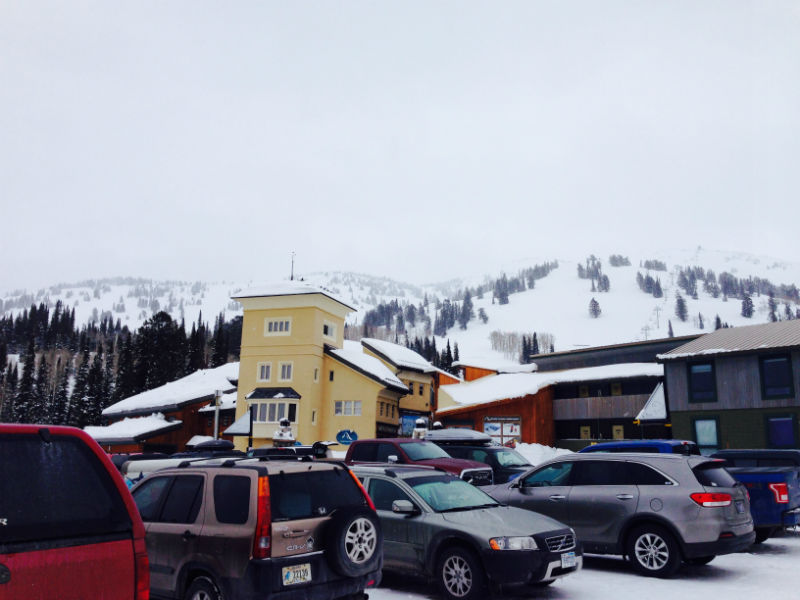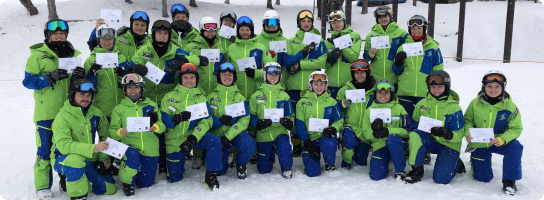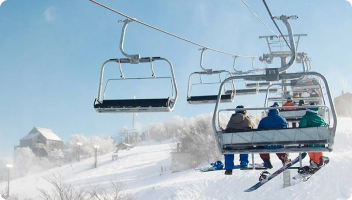Finding the right ski for you makes such a difference to how you will enjoy your season working at the snow. Too much power and you will feel out of control – too little power and you won’t feel like you’re progressing like you want to.
So, let’s break down the core features of skis to understand, and get you talking like a rental shop pro.
Camber
Camber is the old school shape of a ski. The arch in the middle of the ski means that the ski acts kind of like a partially loaded spring. As soon as you put pressure on one side of the ski when you initiate a turn, the two edges at the front of the ski and the back bite into the snow – relative to the rest of the skis – which helps you to turn.
Your weight on the centre of the ski ensures that pressure is distributed along the ski, giving you more even contact with the snow.
Cambered skis will have more ‘spring’ to help you bounce from one turn to the next, which makes it easier to make those quick turns on groomed runs and off-piste runs that aren’t powder or bumpy.
Camber is popular with ski racers as it holds an edge better on-piste and on icy runs. The skis will feel like they have more energy in the turns than a rockered ski, although the really tight turns are a little harder with a cambered ski as you need to work the ski into the turn more than a rockered ski.
The downside to camber is that it is easier to catch an edge, given the shape wants to bite into the snow. The other downside to camber is it can be a harder ski to use in deep powder as opposed to a fully rockered ski.
Camber went out of fashion recently as everyone moved to the rockered ski. But don’t discount camber out of hand – they are probably among the best all-mountain ski shapes, and many of the best all-mountain skis will have some camber to them.
Rocker
Rocker is sometimes known as reverse camber. Rocker is where the skis form a ‘U’ shape when placed on the ground. The design originally came from watersports, where a rocker is common to keep the tips of the skis up.
With a rockered ski, the lift at the edges of the skis means that, when placed on an edge, the skis won’t tend to bite as quickly as a camber ski. It also means the effective edge is a little shorter than in a camber ski given it’s the centre of the skis which will absorb much of the energy of the turn.
The result of this is a ski that struggles a little more on the icy and groomed runs. A rockered ski can also feel quite ‘washy’ as you go along as both edges are slightly raised from the snow, meaning the strongest contact with the snow is directly underfoot.
However, rocker is extremely popular given it is awesome for off-piste and powder. The raised tips allow you to float through the powder. This means you don’t need to lean back like you would with a cambered ski, which allows you to charge harder through the powder and the trees.
Rocker also allow for easier turn manoeuverability as the turn is initiated much more through the foot than through the tips of the skis. This gives you much more ability to ‘swipe’ your feet from side-to-side and make those really tight, off-piste turns.
Some park riders prefer rocker given the less catchy edges allow riders to get into spins early and will provide a greater capacity to recover from off-centre landings.
Flat
Flat skis are a little less common, and are more likely to be seen in a snowboard than a ski. Flat skis have raised tips and a flat base.
Flat is either the best of both worlds, or the worst of both worlds, depending on your perspective. Turning will be easier than with a camber ski, while edge hold will be better than with a full rocker. Conversely, turning is worse than with a full rocker and edge hold not as strong as with a camber ski.
Rocker/Camber/Rocker
Some ski manufacturers try to combine the best of both into one ski. The most common design to incorporate these features is a rocker/camber/rocker. This is a rockered tip and tail, with a camber centre to the ski.
The rocker tips will make it ski shorter than it otherwise would, meaning you might need to go 5-10cm longer than usual.
The camber will give you that ‘spring’ on the groomers, while the rocker allows you to take the ski off-piste and through the powder with confidence.
Twin Tips
Many park skis now have twin tips – i.e. the tail is a similar shape to the tip. The twin tip design allows riders to ski backwards and land backwards, and generally perform cooler tricks.
Ski Length
Optimal ski length will vary a lot based on your ability. For beginners to intermediates, it is generally suggested to get a ski up to your chin. More advanced skiers will go to head height, even sometimes longer.
Shorter skis are easier to turn as there is less ski to move. Shorter skis are better for short, quick turns when going at a medium pace. Shorter skis might also be good for someone who is quite light as there is less need for the ski to grind the edge against the snow.
However, more aggressive skiers generally prefer a longer ski. The reason is a longer ski has much more power in it. At speed, a longer ski will hold better and avoid the ‘chatter’ and wobbliness that comes with a shorter ski. A longer ski will also go faster as it has more edge contact with the snow. Ski racers will go for longer skis (sometimes so long they look almost comical).
Additionally, if going into the backcountry or off-piste, a longer ski powers through the crud a little better than a shorter ski. Longer skis are also generally necessary if you going for a rockered ski, given that a full rocker will make them ski shorter than a camber ski (less edge contact with the snow). Longer skis are also good for those who a heavier than average.
Ski Width
Skis have three width measurements – one at the tip, one at the tail and one underfoot. A measurement of 120/95/110 would mean 120 millimetres at the tip, 95mm underfoot and 110mm at the tail.
The narrower the waist, generally the deeper is the parabolic shape of the ski (the sidecut) which will make the ski easier to turn.
Skis with a wider width underfoot will be better in powder, given the greater surface area of the ski to assist with flotation. However, a wider waist is more work to turn, and generally requires a better technique in order to make the turns.
For a purer groomer ski, 70 – 80mm underfoot is a rough guide as to what constitutes a narrow ski. From 80mm – 95mm is a bit more of an all-mountain ski which has versatility to perform well both on and off-piste well. Wider than 100mm gets into quite a fat ski which will be excellent for those big mountain, off-piste days with lots of powder. Skis go as high as 140mm for regular punters if you are really looking to charge through the crud, or look like you have two snowboards on your feet. Wider than that is getting a little comical and probably counter productive.
For moguls, a narrower ski is generally a bit easier to handle, as is a ski with less of a sidecut to help you shape your turns to the bumps.
Sidecut
Sidecut refers to the difference in width between the waist, and the tip and tail. All skis now have some degree of sidecut – straight skis belong in the 1970s.
From the mid-1990s, the shaped ski, or ‘parabolic’ ski became extremely popular, taking over the from the straight style. This sidecut allows the ski to turn much more easily as it requires the skier to roll the ankles and feet. This partially changed the best technique for skiers. It also meant that the skis could get a little shorter, as the sidecut means pressure is placed over a greater length of the edge of the ski than with a straight ski.
A deep sidecut refers to a bigger difference in width at the tip and tail compared to the waist, as opposed to a narrow sidecut where the curve is more gradual on the ski.
The deeper the sidecut, the tighter a ski will turn.
With the advent of the rockered ski with a wider waist, the popular shape of skis has in general moved back more towards a smalller sidecut with a narrow curve.
Radius
Radius will often be printed on the ski. This refers to the natural turning arc of the ski. A shorter radius means the ski is better for tight turns.
Anything less than 16 metres is considered short. These skis will be good on groomers. From roughly 17m – 22m, you will find skis in the all-mountain range. A ski with a radius of longer than 22m will have a narrow sidecut, and you are likely to find this range among powder and big-mountain skis which are wide underfoot.
You will also find a long radius in the best mogul skis as a straighter ski is much easier to handle in the bumps.
Backcountry and Weight of the Ski
Another factor to take into account is the weight of the ski. Heavier skis, sometimes with a metal rather than a wood core, will charge through ice and crud more easily than a light ski. However, if you are planning on doing a bit of backcountry, remember you will need to carry your skis. A light ski could be quite a gift when trudging up the hill for the fourth time that day!
Flex and Bend
The flex of the ski is how much the ski will bend as pressure is applied. You might often see people in shops trying to look like they know their stuff by bending the skis through the waist!
A more flexible ski is good for beginners as it is a little more forgiving if you hit a rough patch, much like suspension in a car.
For advanced skiers, stiffness is generally preferred as it allows you to charge through the icy and cruddy snow much more easily. A stiffer ski will also feel more stable at speed, and is therefore preferred by racers and aggressive skiers.
A stiffer ski will also avoid the ‘chatter’ and bumpiness that a soft ski will betray as you move into a higher gear.
On the other hand, a softer ski is nice when the snow is very powdery as a stiffer ski will sink a little and not float as nicely. A stiffer ski is also harder to turn in the powder, although it might be better for heavier than average people.
Torsional Stiffness
This refers to the stiffness in the ski when twisting the ski in an upright position. It is the other dimension in which a ski can bend. Some skis are built-up through the middle of the skis to give greater torsional strength. The advantage here is that a soft, flexible ski, which would otherwise not handle the groomers as well, can be designed so that it has additional torsional strength to compensate for the softer, more flexible design. Greater torsional strength gives more strength when holding an edge.
An example of a torsionally stiff ski with a softer flex is the Volkl 90eights.
Gender Considerations
As ski manufacturers like to make more money from us, there are differences between men’s and women’s skis. Women’s skis are generally lighter. The waist, and where the binding is place, is often set further forward to match a women’s relatively lower centre gravity (weight contained in the thighs for women, rather than around the gut for men – all else being equal!). However, the differences are slight and probably not a huge consideration when buying skis.
Pick a Ski for the Right Location
Among good riders, you will often find people with several sets of skis. This is because there is no perfect ski for all conditions. There are trade-offs with every element of design.
For those riding in deep, soft snow such as in the Rockies in Canada or the US, or through Japan, a soft, wide, long ski is a popular choice.
For those who are riding in icier conditions with heavier snow, such as Australia, New Zealand, South America, and often Europe, a stiffer ski with a narrower waist is often popular. However, even in these places the wider skis underfoot are becoming more popular as people realise their versatility.
Ski Brands
The biggest brands in the world are European in origin, and France is over-represented in producing some of the most well-known manufacturers.
Elan is the pioneer of the parabolic design of ski from the mid-1990s. It is a Slovenian-originating company with headquarters still in Slovenia.
Rossignol is a leading ski designer which was founded back in 1907 in France, and which is now the owner of Dynastar and Lange.
K2 is an American company started in the 1960s, and was the first user of fibreglass technology in skis.
Salomon was started in Annecy, France in the 1940s.
Dynastar is owned by the Rossignol group, and was originally a French company founded in the 1960s.
Atomic is an Austrian company which has been at the forefront of technology changes in skis and boots.
Head is a Dutch company which is also well-known in other sports such as tennis.



